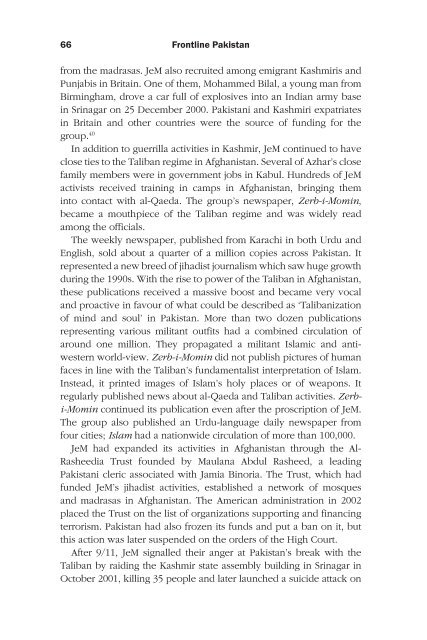Frontline Pakistan : The Struggle With Militant Islam - Arz-e-Pak
Frontline Pakistan : The Struggle With Militant Islam - Arz-e-Pak
Frontline Pakistan : The Struggle With Militant Islam - Arz-e-Pak
Create successful ePaper yourself
Turn your PDF publications into a flip-book with our unique Google optimized e-Paper software.
<strong>Frontline</strong> <strong><strong>Pak</strong>istan</strong><br />
from the madrasas. JeM also recruited among emigrant Kashmiris and<br />
Punjabis in Britain. One of them, Mohammed Bilal, a young man from<br />
Birmingham, drove a car full of explosives into an Indian army base<br />
in Srinagar on 25 December 2000. <strong><strong>Pak</strong>istan</strong>i and Kashmiri expatriates<br />
in Britain and other countries were the source of funding for the<br />
group. 40<br />
In addition to guerrilla activities in Kashmir, JeM continued to have<br />
close ties to the Taliban regime in Afghanistan. Several of Azhar’s close<br />
family members were in government jobs in Kabul. Hundreds of JeM<br />
activists received training in camps in Afghanistan, bringing them<br />
into contact with al-Qaeda. <strong>The</strong> group’s newspaper, Zerb-i-Momin,<br />
became a mouthpiece of the Taliban regime and was widely read<br />
among the officials.<br />
<strong>The</strong> weekly newspaper, published from Karachi in both Urdu and<br />
English, sold about a quarter of a million copies across <strong><strong>Pak</strong>istan</strong>. It<br />
represented a new breed of jihadist journalism which saw huge growth<br />
during the 1990s. <strong>With</strong> the rise to power of the Taliban in Afghanistan,<br />
these publications received a massive boost and became very vocal<br />
and proactive in favour of what could be described as ‘Talibanization<br />
of mind and soul’ in <strong><strong>Pak</strong>istan</strong>. More than two dozen publications<br />
representing various militant outfits had a combined circulation of<br />
around one million. <strong>The</strong>y propagated a militant <strong>Islam</strong>ic and antiwestern<br />
world-view. Zerb-i-Momin did not publish pictures of human<br />
faces in line with the Taliban’s fundamentalist interpretation of <strong>Islam</strong>.<br />
Instead, it printed images of <strong>Islam</strong>’s holy places or of weapons. It<br />
regularly published news about al-Qaeda and Taliban activities. Zerbi-Momin<br />
continued its publication even after the proscription of JeM.<br />
<strong>The</strong> group also published an Urdu-language daily newspaper from<br />
four cities; <strong>Islam</strong> had a nationwide circulation of more than 100,000.<br />
JeM had expanded its activities in Afghanistan through the Al-<br />
Rasheedia Trust founded by Maulana Abdul Rasheed, a leading<br />
<strong><strong>Pak</strong>istan</strong>i cleric associated with Jamia Binoria. <strong>The</strong> Trust, which had<br />
funded JeM’s jihadist activities, established a network of mosques<br />
and madrasas in Afghanistan. <strong>The</strong> American administration in 2002<br />
placed the Trust on the list of organizations supporting and financing<br />
terrorism. <strong><strong>Pak</strong>istan</strong> had also frozen its funds and put a ban on it, but<br />
this action was later suspended on the orders of the High Court.<br />
After 9/11, JeM signalled their anger at <strong><strong>Pak</strong>istan</strong>’s break with the<br />
Taliban by raiding the Kashmir state assembly building in Srinagar in<br />
October 2001, killing 35 people and later launched a suicide attack on













